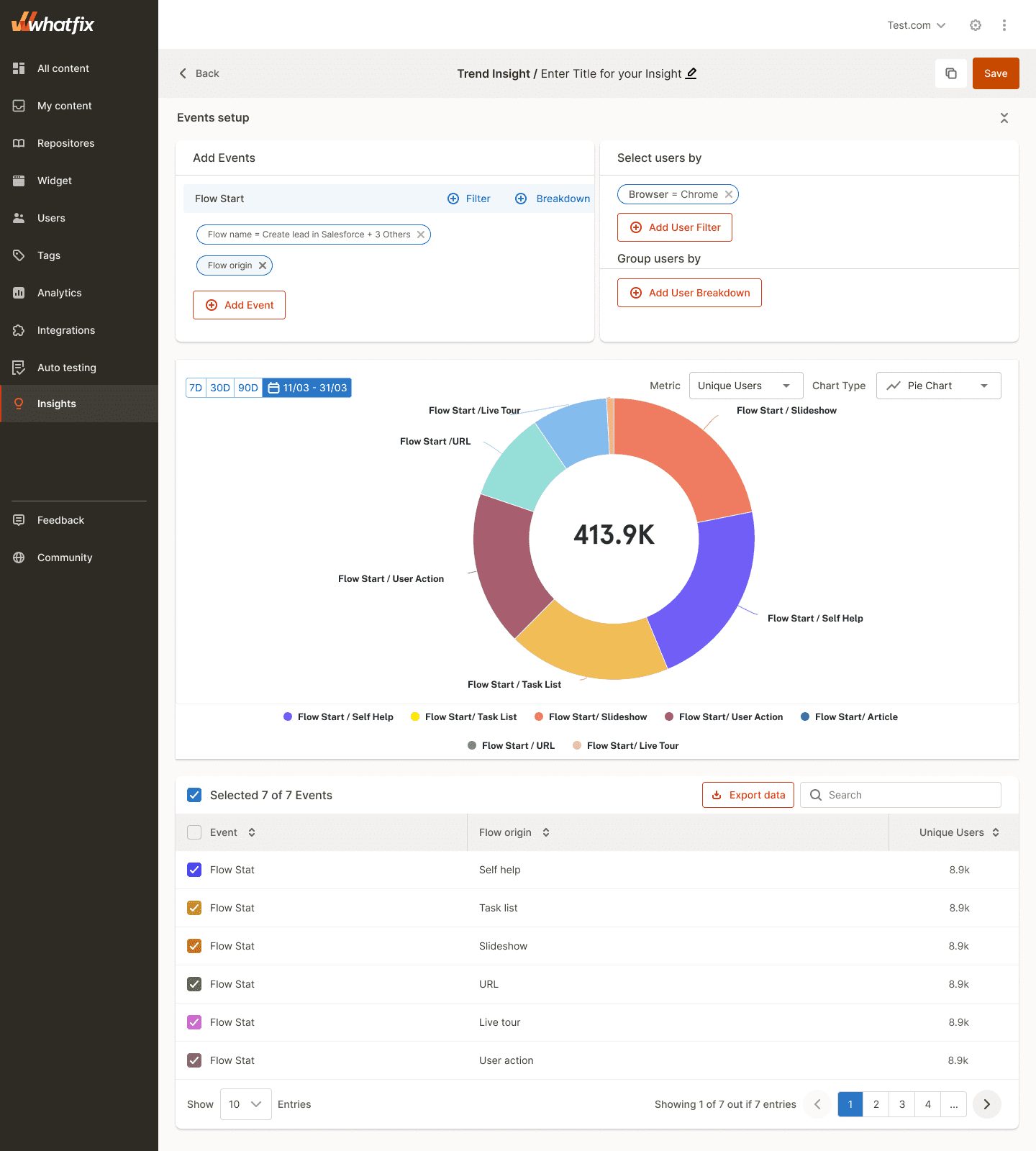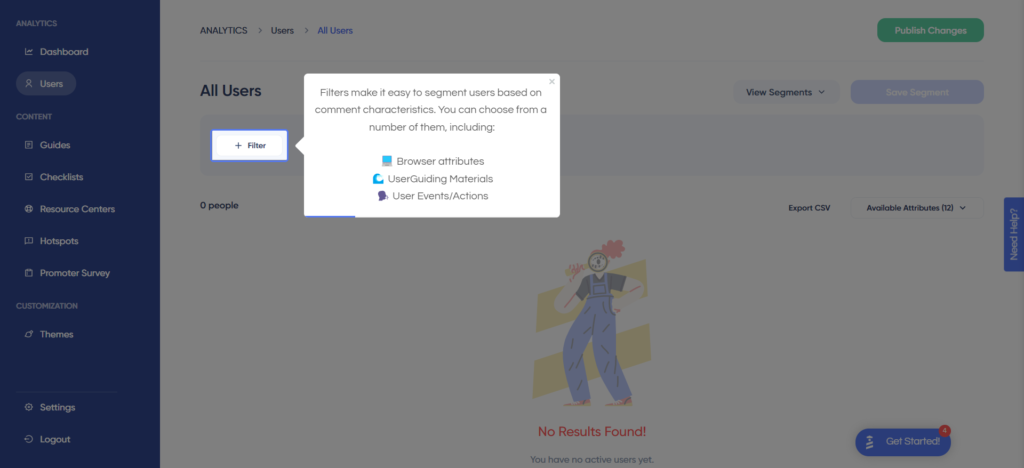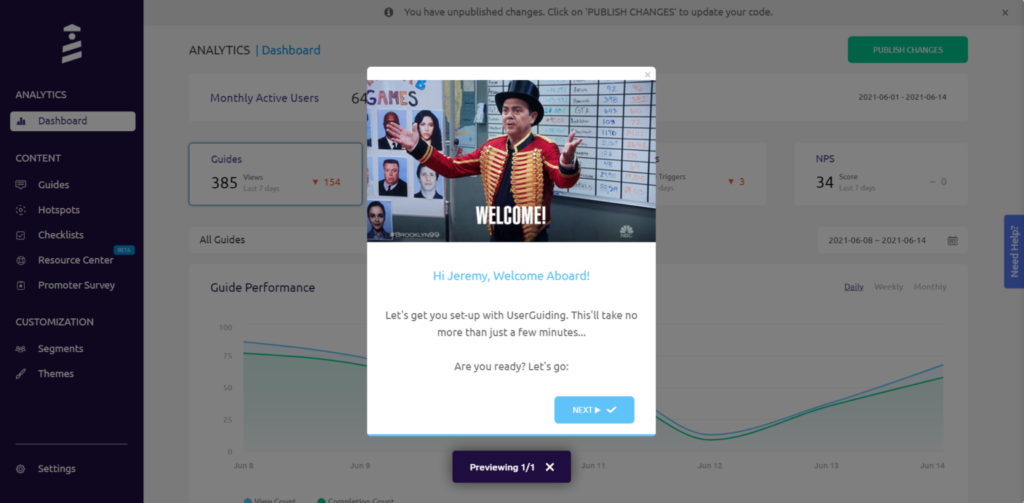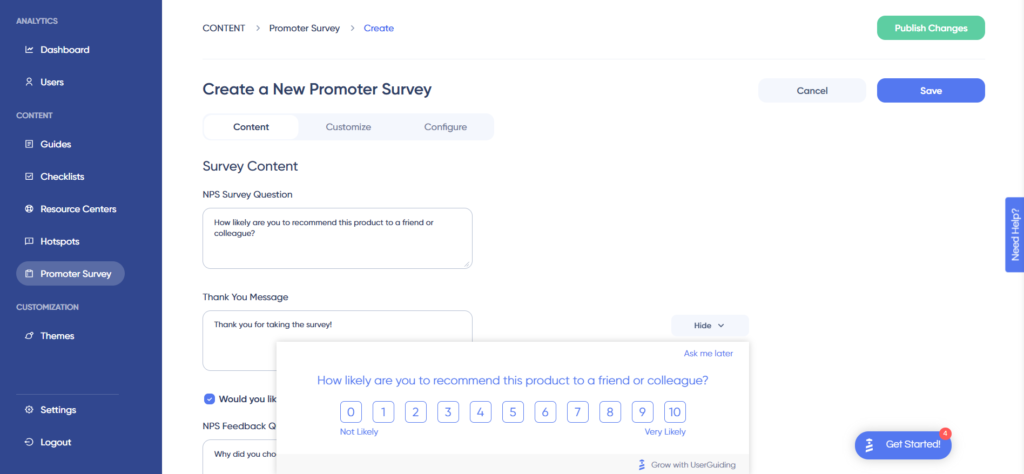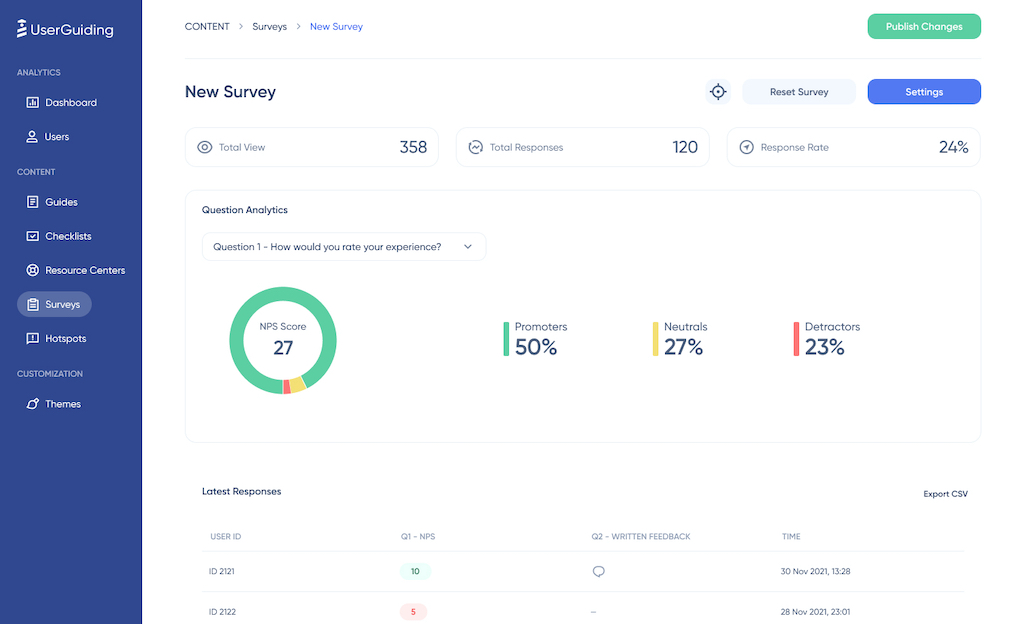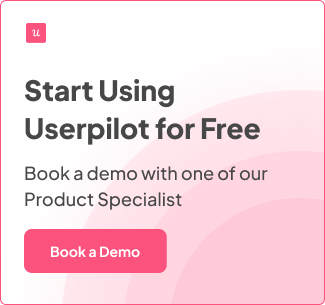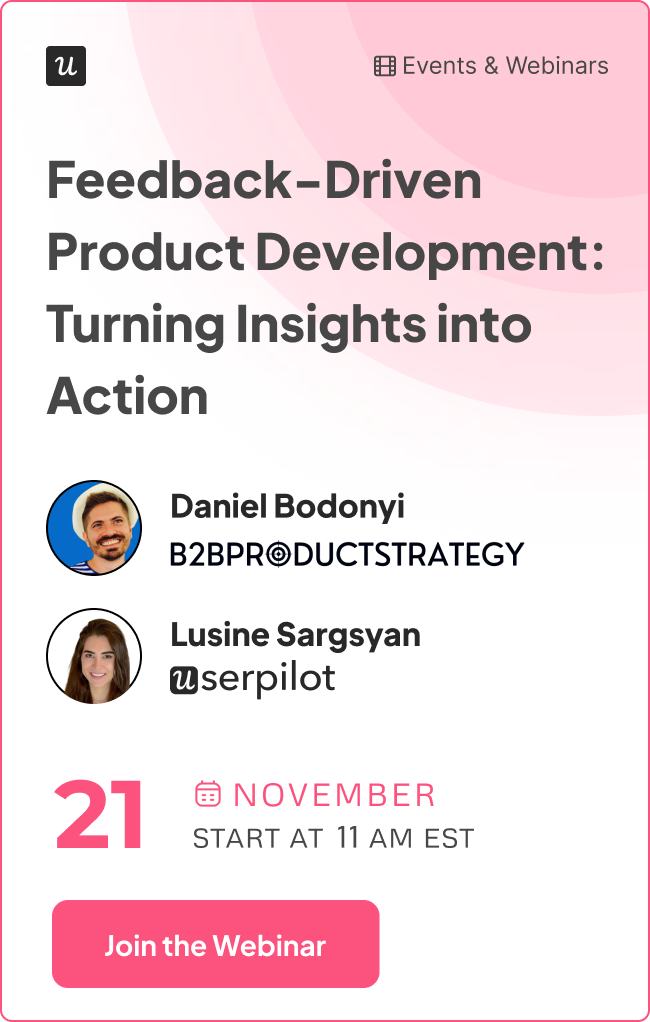UserGuiding vs Whatfix: Which is Best for Your SaaS?
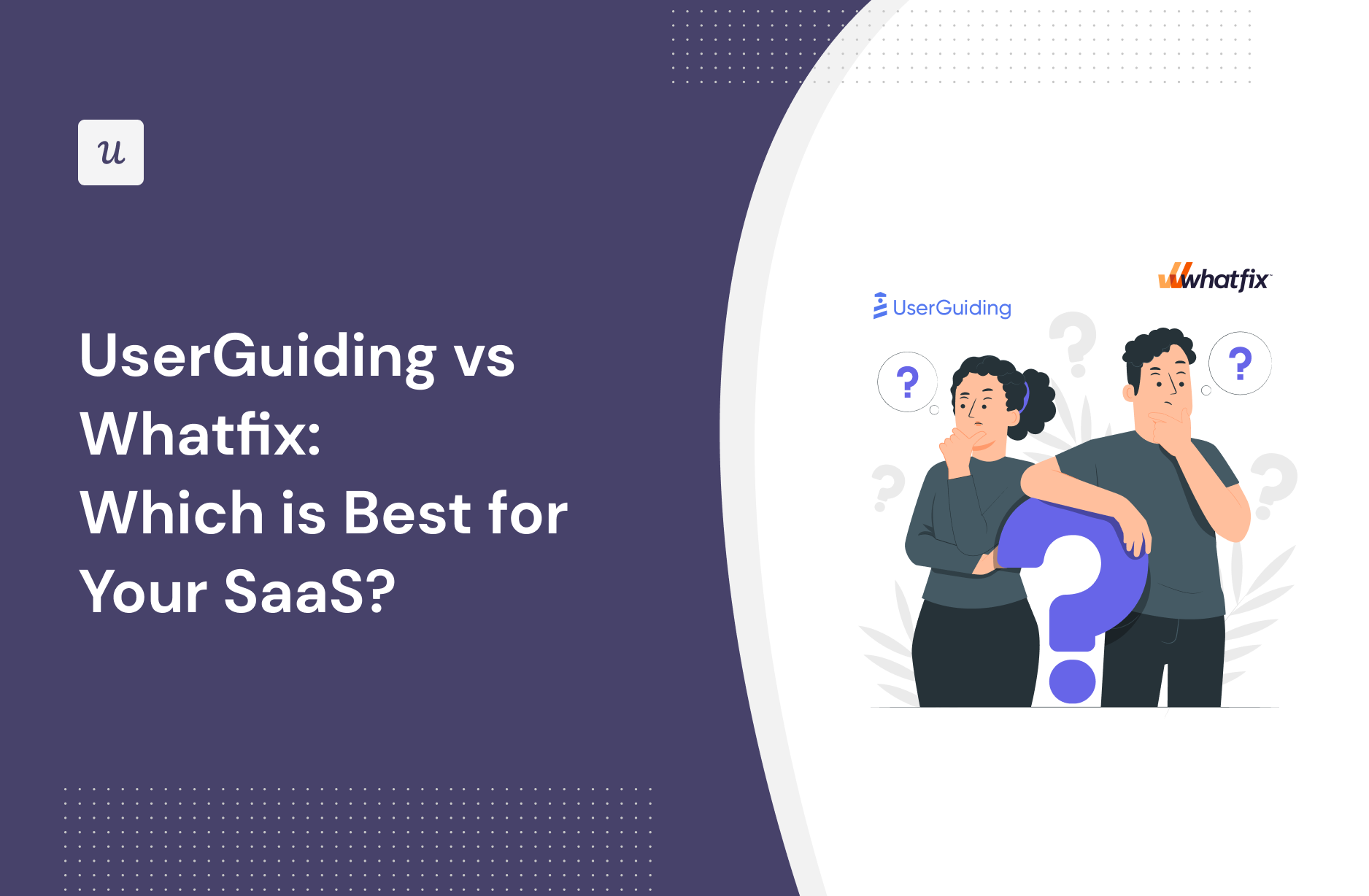
UserGuiding vs Whatfix: Comparison summary
- Let’s explore how UserGuiding, and Whatfix compare when it comes to user onboarding and other common use cases.
-
- UserGuiding is a no-code product adoption tool that lets users create in-app walkthroughs, guides, and checklists. The solution makes it possible for teams to onboard, engage, and retain users without needing coding skills to create these in-app experiences.
- Whatfix is a digital adoption platform that helps enterprise organizations with onboarding, training, and supporting their employees or customers. It accomplishes this through in-app guidance and messaging to provide on-demand support whenever it’s needed.
-
- If you’re looking for a better option for user onboarding, Userpilot exceeds both functionality and value for money compared to other tools on the list.
- Userpilot is a product growth platform that drives user activation, feature adoption, and expansion revenue. It also helps product teams collect user feedback, streamline onboarding, and gather actionable insights from analytics. Get a Userpilot demo for user onboarding and drive your product growth code-free.
What is UserGuiding?
UserGuiding is a no-code product adoption tool that lets users create in-app walkthroughs, guides, and checklists. The solution makes it possible for teams to onboard, engage, and retain users without needing coding skills to create these in-app experiences.
All in all, UserGuiding is a pretty flexible solution that can improve the onboarding process, boost user engagement, and increase customer retention.
What is Whatfix?
Whatfix is a digital adoption platform that helps enterprise organizations with onboarding, training, and supporting their employees or customers. It accomplishes this through in-app guidance and messaging to provide on-demand support whenever it’s needed.
The solution also lets you track analytics on all in-app guidance, collect user feedback, build out self-serve content, and automate certain flows. Whatfix even has integrations with Salesforce, Amplitude, Google Analytics, Slack, Confluence, and other platforms to maximize collaboration.
UserGuiding vs Whatfix for user onboarding
In this section of the article, we’re really going to compare UserGuiding vs Whatfix in terms of user onboarding. That way, we’ll be able to figure out which tool – UserGuiding or Whatfix – is the best option depending on your use case.
UserGuiding for user onboarding
As a no-code onboarding tool, UserGuiding has numerous features that will help you create onboarding flows for your new customers and guide them throughout their journey.
Here’s what you’ll get when you start using UserGuiding:
- Create interactive product walkthroughs without disturbing your developers as it’s completely code-free.
- Build onboarding checklists and drive customers to the activation point by eliminating the guesswork on what the next step should be.
- Create interactive elements, such as product tours, tooltips, and pop-ups, to help keep users engaged and increase the likelihood that they’ll complete the onboarding process.
- Create a resource center to add different educational resources for your users.
Though UserGuiding is a great tool for startups that don’t have much money to invest in an onboarding tool, it has very strict limitations for the Basic plan.
You can only create a maximum of 20 guides and hotspots, 2 onboarding checklists, and 1 resource center. If you want to create unlimited guides with unlimited UI patterns, you should go for the Professional plan which can cost from $299 to $399.
The one drawback when using UserGuiding for onboarding is the fact that its analytics dashboard only encompasses the elements that you’ve created within the platform. In contrast, Userpilot is able to track all elements, events, and behaviors throughout the entire user journey.
Whatfix for user onboarding
User onboarding is a complex process that only the most flexible tools can pull off. Whatfix has its fair share of bugs and technical quirks but there are a few features that bolster its onboarding capabilities — namely its tours, checklists, and integrations.
Here’s an overview of Whatfix’s onboarding features:
- Whatfix lets you create interactive product tours for both users and employees. This reduces the time to value (TTV), whether it’s for customers using your product or employees learning how to use a solution in the internal tool stack.
- Onboarding checklists (known as task lists on Whatfix) give new users or employees a clear next step on their journey toward product adoption. Whatfix lets you create these checklists as widgets target specific segments, and group tasks under headers.
- Whatfix’s gallery of direct integrations with tools like Salesforce, Amplitude, SurveyMonkey, and more helps you centralize all onboarding data. The onboarding metrics gathered and synced across tools can then help you streamline your in-app flows.
UserGuiding vs Whatfix for product adoption
In this section of the article, we’re really going to compare UserGuiding vs Whatfix in terms of product adoption. That way, we’ll be able to figure out which tool – UserGuiding or Whatfix – is the best option depending on your use case.
UserGuiding for product adoption
UserGuiding has multiple features that can promote product adoption early in the user journey (especially during the onboarding process).
Some features that you could deploy when using UserGuiding for your product adoption efforts include:
- Onboarding checklists: While the onboarding checklist is generally used for profile setups and introducing users to specific features, it can also be used to help users learn more about the product and various ways to begin getting value out of it.
- Surveys: Because qualitative feedback is a necessary part of guiding your digital adoption strategy, creating a survey with UserGuiding could help you gather the insights that you need to streamline the adoption journey for your users (but we’d suggest going for the Professional tier so you can have three different surveys active simultaneously).
- Guides: Guides created with UserGuiding can have either a single step or multiple steps which gives you the flexibility to test different combinations and see which setup reduces friction or increases digital adoption amongst users.
- Hotspots: Much like onboarding checklists, hotspots are primarily utilized to highlight a specific feature. However, you can use the UserGuiding dashboard to see the total number of hotspot clicks to gauge product adoption on a broader level (unfortunately it only displays interactions that occurred in the past seven days).
- Resource center: Customer education is a crucial part of driving product adoption so using UserGuiding to create a resource center is a handy way to teach new users how the product works.
Whatfix for product adoption
User onboarding is a complex process that only the most flexible tools can pull off. Whatfix has its fair share of bugs and technical quirks but there are a few features that bolster its onboarding capabilities — namely its tours, checklists, and integrations.
Here’s an overview of Whatfix’s onboarding features:
- Whatfix lets you create interactive product tours for both users and employees. This reduces the time to value (TTV), whether it’s for customers using your product or employees learning how to use a solution in the internal tool stack.
- Onboarding checklists (known as task lists on Whatfix) give new users or employees a clear next step on their journey toward product adoption. Whatfix lets you create these checklists as widgets target specific segments, and group tasks under headers.
- Whatfix’s gallery of direct integrations with tools like Salesforce, Amplitude, SurveyMonkey, and more helps you centralize all onboarding data. The onboarding metrics gathered and synced across tools can then help you streamline your in-app flows.
UserGuiding vs Whatfix for customer experience
In this section of the article, we’re really going to compare UserGuiding vs Whatfix in terms of customer experience. That way, we’ll be able to figure out which tool – UserGuiding or Whatfix – is the best option depending on your use case.
UserGuiding for customer experience
Because UserGuiding was built with the goal of creating no-code onboarding flows, its features are better suited to the earlier stages of the user journey rather than the full course of the customer experience.
That said, there are still certain UserGuiding features that can be adapted for customer experience optimization:
- Surveys: Customer experience optimization (CXO) is heavily reliant on gathering feedback that can help improve and streamline user journeys. Collecting qualitative feedback with UserGuiding surveys can be the first step towards improving the customer experience.
- MAUs: While the MAU metric isn’t as granular as customer satisfaction metrics like NPS or CSAT scores, looking at trends in how many MAUs your product is getting from month to month can help you determine if the customer experience is getting better or worse.
- Activity feed: UserGuiding’s activity feed can show you which areas of the tool users have been engaging with the most. You can then use these insights to identify areas where the customer experience could be improved.
Whatfix for customer experience
Customer experience insights are imperative for understanding how people use your product. Whatfix can be used to improve the product experience both for customers as well as your employees using internal software.
Here are the Whatfix features you can use to improve the customer experience:
- You can collect feedback from your customers or employees while they’re actively using a software application. These input fields can be used to collect feedback on the customer experience or specific aspects of the product.
- Ask scalar, multiple choice, and open-ended questions to get an accurate view of net promoter scores (as well as the driving forces behind each rating). Note that you’ll only be able to edit, delete, or reorder questions if you upgrade to Premium.
- Adding tooltips, hotspots, and beacons on top of a piece of software using Whatfix can draw attention toward specific features. Whatfix tooltips are particularly helpful because they expand when hovered over and provide additional information to users.
UserGuiding vs Whatfix for user feedback
In this section of the article, we’re really going to compare UserGuiding vs Whatfix in terms of user feedback. That way, we’ll be able to figure out which tool – UserGuiding or Whatfix – is the best option depending on your use case.
UserGuiding for user feedback
With surveys being UserGuiding’s only feedback collection, the platform is better suited to user feedback than product feedback. After all, product feedback should be comprehensive and gathered from multiple sources such as customer interviews or support ticket analysis.
Here are some UserGuiding features you could consider using to collect product feedback:
- Surveys: Due to the limitations of the Basic plan, UserGuiding surveys could be more useful when collecting user feedback. Product feedback surveys usually focus on a specific area or feature which means you’ll need more than one active survey running concurrently.
- Net Promoter Score (NPS): While satisfaction metrics like Net Promoter Scores fall into the quantitative data category, looking at NPS trends both before and after a major product update can help you determine how users are responding to the latest set of changes.
- Checklists: Checklists are traditionally used to facilitate onboarding and feature discovery but you could conceivably add a step that prompts users to leave product feedback after completing their product tour.
Note: Because UserGuiding only lets users on the Basic plan have one survey active at a time, there’s a high likelihood that the volume of product feedback you’re able to collect will be bottlenecked at some point.
Whatfix for user feedback
Product feedback can help you identify friction points, squash bugs, and improve the overall experience for customers or employees using a piece of software. Whatfix lets you collect different types of feedback from users across multiple platforms:
- Whatfix has feedback forms that let users submit their feedback at any point in the product journey. This makes it easy to ask about specific features while a customer or employee is actively using it — leading to higher response rates and more accurate feedback.
- Whatfix’s surveys aren’t limited to PC users, as you’ll also be able to collect feedback from customers and employees who are on mobile devices. Whatfix lets you adjust the design and placement of your mobile surveys (either full screen, centered, or bottom).
- Lastly, Whatfix also lets you build NPS surveys that help with customer satisfaction benchmarking. Sadly, these surveys are quite limited on the Standard plan and you’ll have to upgrade to Premium if you hope to edit, delete, or reorder questions.
UserGuiding vs Whatfix: Which one you should choose?
To further simplify this selection process, let’s break down the strengths and limitations of each tool. Understanding the distinct advantages and potential drawbacks of UserGuiding and Whatfix will provide you with a detailed roadmap for making a well-informed decision!
Pros and cons of UserGuiding
Pros of UserGuiding
UserGuiding has quite a few benefits as a product adoption solution, particularly for early-stage SaaS companies that need an easy-to-use starter tool for their small (but growing) team of product developers or marketers. Let’s look at some of the pros that UserGuiding has to offer:
- Chrome extension – UserGuiding utilizes a no-code Chrome extension.
- Survey template gallery – UserGuiding lets you choose from six survey templates or create your own survey from scratch.
- Analytics dashboard – users can see their monthly active users (MAUs) for the month, monitor the number of views their guides are getting, and see how many interactions checklists or resource centers have had in the past week from the UserGuiding homepage.
- Custom themes – granular theme customization and color selection.
- Easy onboarding – onboarding checklist walks you through key steps, such as how to get the UserGuiding Chrome extension and create your first guide.
Cons of UserGuiding
While there are quite a few benefits to using UserGuiding, there are three significant drawbacks to note:
- Dashboard customization – you can’t edit your home dashboard or choose which analytics you want to see.
- Pricing jumps – upgrading from Basic (2,500 MAUs) to Professional (20,000 MAUs) increases your subscription cost by more than 4x.
- Manual localization – UserGuiding doesn’t have AI-powered localization, so you’ll need to manually download, translate, and upload every CSV when attempting to localize content for your product.
- HubSpot integration – the UserGuiding-HubSpot integration is only a one-way integration which limits its functionality and prevents you from setting up two-way data synchronization between both platforms.
- Limited analytics – the analytics dashboard only shows you data for onboarding materials created with UserGuiding and even those analytics are quite limited as surveys only show you total responses rather than letting you select a date range.
- Survey limit – you can only have one active survey on the Basic plan which is disappointing considering UserGuiding costs over $1,000 annually (whereas Userpilot lets you create unlimited surveys and collect up to 250 responses per month on the cheapest plan).
Pros and cons of Whatfix
Pros of Whatfix
Whatfix may not be as popular or widely adopted as competitors like WalkMe but it does have its fair share of benefits:
- Pricing: While Whatfix does not publish the exact cost of its plans publicly, numerous reports from customers suggest an average entry point of $1,000/month. This is significantly cheaper than its closest competitor, WalkMe, which reportedly starts at closer to $10,000/month.
- Automation: Whatfix Flows helps you automate repetitive tasks to save time. The Whatfix Flows dashboard also lets you analyze your existing flows and then use them to create entirely new automation in a single click.
- Integrations: Whatfix’s third-party integration options make it easy to incorporate the solution into the rest of your tech stack. It integrates with Salesforce, Amplitude, Google Analytics, Slack, and more — providing a good selection of the top CRM, analytics, and communication tools.
Cons of Whatfix
Whatfix offers a more affordable employee onboarding solution than its closest competitors but is limited by its lackluster analytics and support — along with its high-friction trial signup process for prospective customers.
Here are the key drawbacks of using Whatfix:
- Whatfix is quite lacking in the analytics department — both in comparison to direct competitors like WalkMe as well as other onboarding solutions like Userpilot, Appcues, or Pendo. If detailed user data matters to you, you’ll want to consider alternatives.
- Technical assistance (or the lack thereof) is arguably one of Whatfix’s largest weaknesses. While all plans promise to give you a customer success manager, most Whatfix users complain about the subpar support they provide.
- While Whatfix has a trial request page on its website, this form is buggy and inconsistent. You can reach out to support to request a trial directly but resolution times can be upwards of a month — and, in the end, you may even be redirected to a demo call instead of a trial account.
Userpilot – A better alternative for your SaaS
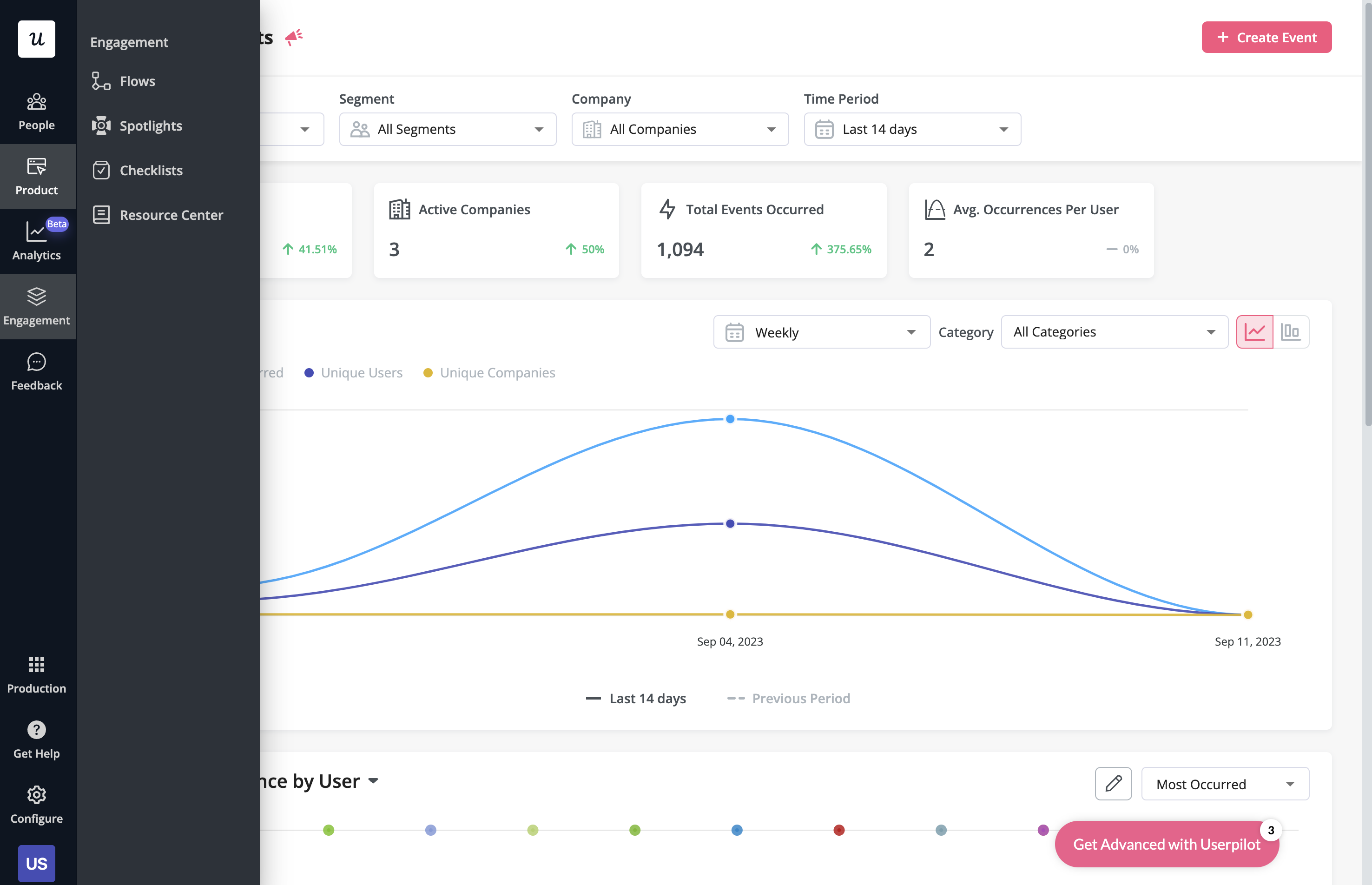
With Userpilot, you’ll be able to track both product usage and user behavior to get a holistic view of how customers use your product — which will guide future development, improve the user experience, and inform your growth efforts.
Pros of Userpilot
As a full-suite digital adoption platform, Userpilot has all the features you need to onboard users, track analytics, and gather feedback from customers without writing a single line of code. Here are a few pros of using Userpilot as your product growth solution:
- No-code builder: Userpilot’s Chrome extension lets you build flows, add UI elements, and tag features without writing a single line of code.
- UI patterns: There are plenty of UI patterns to choose from when using Userpilot, such as hotspots, tooltips, banners, slideouts, modals, and more!
- Startup-friendly: Userpilot’s entry-level plan gives you access to all available UI patterns so you can hit the ground running.
- Walkthroughs and flows: Build engaging interactive walkthroughs and personalized onboarding flows that target specific segments of your user base.
- Self-service support: Build an in-app resource center to help users solve problems, customize its appearance to align it with your brand, and insert various types of content (videos, flows, or chatbots) to keep your customers satisfied.
- A/B testing: Userpilot’s built-in A/B testing capabilities will help you split-test flows, iterate on the best-performing variants, and continually optimize based on user behavior.
- Feedback collection: Userpilot has built-in NPS surveys with its own unified analytics dashboard and response tagging to help you retarget users. There are other survey types to choose from and you can even create your own custom survey.
- Survey templates: There are 14 survey templates to choose from so you can gather feedback on specific features or run customer satisfaction benchmarking surveys like CSAT and CES.
- Advanced analytics: Userpilot lets you analyze product usage data, monitor engagement on all in-app flows, and use the data to create user segments that are based on behaviors instead of demographics.
- Event tracking: Userpilot’s no-code event tracking lets you tag UI interactions (hovers, clicks, or form fills) and group them into a custom event that reflects feature usage.
- Third-party integrations: Userpilot has built-in integrations with tools like Amplitude, Mixpanel, Kissmetrics, Segment, Heap, HubSpot, Intercom, Google Analytics, and Google Tag Manager so you can share data between all the solutions in your tech stack.
Cons of Userpilot
Of course, no tool is perfect and there are a few cons to consider before choosing Userpilot as your user onboarding or product growth solution:
- Employee onboarding: Currently, Userpilot only supports in-app customer onboarding.
- Mobile apps: Userpilot doesn’t have any mobile compatibility which could make it difficult for developers with cross-platform applications to create a consistent user experience for both versions of their product.
- Freemium plan: There’s no freemium Userpilot plan so those bootstrapping their startup and need sub-$100 solutions should consider more affordable onboarding platforms like UserGuiding or Product Fruits.
Conclusion
Hopefully, this post helped you decide whether UserGuiding or Whatfix is more appropriate for your company. As you can see – both have many upsides and downsides.
Undeniably, Userpilot provides a better value for money and is a better choice for a mid-market SaaS, especially when it comes to user onboarding and user feedback.
If you’re interested in finding more, book a demo with our team here!
Try Userpilot – The best user onboarding solution for SaaS

